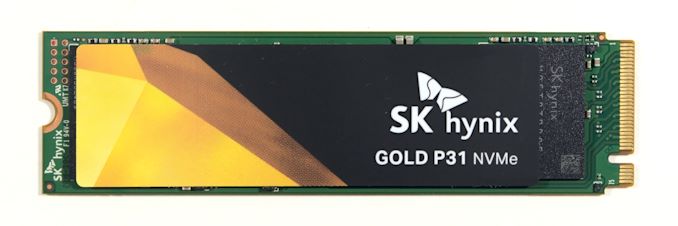The Best NVMe SSD for Laptops and Notebooks: SK hynix Gold P31 1TB SSD Reviewed
by Billy Tallis on August 27, 2020 8:00 AM ESTConclusion
I've rolled my eyes every time SK hynix uses their "4D NAND" moniker to describe their combination of a peripheral under cell layout and charge trap flash. It seemed like a silly exaggeration of a minor advance over other 3D NAND, especially since Intel and Micron have been doing "CMOS under the Array" since their first generation of 3D NAND. But now that I've tested a SSD using this "4D NAND" for the first time, I'll admit it's not purely marketing fluff. This is a genuinely impressive product, and the new 3D NAND seems to be a very important factor. In some very important ways, SK hynix has taken the technological lead, even if this position may not last long.
The SK hynix Gold P31 at first glance seems to be a fairly ordinary high-end NVMe drive, albeit still limited to PCIe 3.0 speeds. It offers well-rounded performance but sets few performance records for this market segment. The write endurance ratings are good and it hit the market with competitive pricing from day one. Taken together with last year's release of the decent Gold S31 SATA SSDs, this is enough to establish SK hynix as an important player in the retail consumer SSD market.
But that's not the whole story when it comes to the Gold P31. The drive's power efficiency is far above the competition; it uses less power than many SATA SSDs while delivering high-end NVMe performance. Thanks to good co-design of their 128L 3D NAND and their in-house NVMe SSD controller, SK hynix has completely redefined our standards for NVMe SSD power efficiency and turned in the most surprising benchmark results in my five years of working for AnandTech.
| High-End NVMe SSD Price Comparison August 26, 2020 |
||||
| 240-280GB | 480-512GB | 960GB-1TB | 2TB | |
| SK hynix Gold P31 | $74.99 (15¢/GB) |
$134.99 (13¢/GB) |
||
| ADATA XPG SX8200 Pro | $44.99 (18¢/GB) |
$69.99 (14¢/GB) |
$134.99 (13¢/GB) |
$249.99 (12¢/GB) |
| Inland Premium | $43.99 (17¢/GB) |
$64.99 (13¢/GB) |
$119.99 (12¢/GB) |
$234.99 (11¢/GB) |
| Team MP34 | $44.99 (18¢/GB) |
$66.99 (13¢/GB) |
$122.99 (12¢/GB) |
|
| Crucial P5 | $54.95 (22¢/GB) |
$79.95 (16¢/GB) |
$149.95 (15¢/GB) |
$339.95 (17¢/GB) |
| WD Black SN750 | $54.99 (22¢/GB) |
$69.99 (14¢/GB) |
$134.99 (13¢/GB) |
$329.99 (16¢/GB) |
| Samsung 970 EVO Plus | $69.99 (28¢/GB) |
$99.99 (20¢/GB) |
$189.99 (19¢/GB) |
$369.99 (18¢/GB) |
| Corsair Force MP600 | $109.99 (22¢/GB) |
$194.99 (19¢/GB) |
$379.99 (19¢/GB) |
|
Surprises like this are why I wish more SSD vendors would sample their OEM drives for review. The P31 is far from SK hynix's first NVMe SSD. It's just the first consumer NVMe SSD they're selling directly as a retail product. They have been manufacturing client NVMe SSDs for years for PC OEMs, but those never find their way onto our SSD testbed.
Some of the first M.2 PCIe SSDs (Samsung XP941 and SM951) were OEM-only products, shipping well before the launch of the retail 950 PRO. We've now seen about six iterations of Samsung's M.2 PCIe SSDs go across our testbeds (in part thanks to help from third-party suppliers who provided some of those OEM-only models for us to review), and because of that we can chart the evolution of their storage technology. But this SK hynix drive comes more or less out of the blue.
Western Digital's first in-house NVMe controllers were announced alongside a pair of OEM drives. The high-end one (SN720) was followed up by a retail counterpart (WD Black gen2) a few months later. I asked Western Digital for a sample of the entry-level OEM SN520 when they introduced that second-generation WD Black, but they couldn't sample it to me. Much later, the retail SN500 arrived and raised the bar for DRAMless SSD performance. More recently, Micron's 2200 series client SSD with their in-house NVMe controller was announced over a year before the Crucial P5 arrived.
Toshiba (now Kioxia) has been the exception; in the past few years they have sampled the XG5, XG6 and BG4 to show off new SSD tech before it makes it into retail drives. OEM SSD products are often managed by separate departments that don't have any PR budget beyond one or two press releases a year. These drives don't need aggressive marketing, but without any review sampling whatsoever we're clearly missing important parts of the picture of the overall SSD market. It's also nice when we can confirm that the drives being used by eg. Dell aren't crap badly in need of an aftermarket replacement.
Even though a close look at recent OEM NVMe SSDs from SK hynix may have tempered the surprise of the Gold P31, it's still an impressive product. It shoots right to the top of my list of recommended SSDs for laptops and finally erases the lingering power efficiency advantage of SATA SSDs, and as a result of that we're giving it one of our coveted Recommended By AnandTech awards.

SK hynix Gold P31: The New Standard for NVMe Laptop SSDs
The SK hynix Gold P31 provides a preview of what how the entry-level NVMe SSD market segment will advance over the next few years, especially as the high-end moves on to PCIe gen4. The Gold P31 still retains plenty of performance for almost all consumer use cases, and will be excellently comfortable sitting in a laptop.











80 Comments
View All Comments
MrCommunistGen - Thursday, August 27, 2020 - link
Truly impressive drive! I'm glad you were able to confirm that the power efficiency numbers held up and weren't the result of some kind of measurement error. When the Platinum P31 comes out I'll probably snag a 2TB model to upgrade my 1TB XG6 in my main ITX rig.Interesting that you mentioned the SN520. I needed a 2242 or 2230 SSD for a project I'm working on and was trying to decide between a BG4 and the SN520. I was able to refer to the previous Anandtech 1TB BG4 review but even then, I'm looking at either a 128GB or 256GB drive as that's what's available 2nd hand on eBay and the 1TB drive's performance isn't going to really represent the smaller drives.
On the other hand I've found exactly nothing on the SN520.
They're cheap enough so I decided to just buy one of each and test them both and see how they compare.
Luminar - Thursday, August 27, 2020 - link
The 2280 form factor SN500s/SN520s are more common than the 2242s and 2230s.I would buy a 2280 SN520 and just Dremel it down to a 2242 form factor. It's been proven to work. As Anandtech wrote in their review, the electronics are only in the first 30mm of the PCB.
MrCommunistGen - Thursday, August 27, 2020 - link
For the heck of it I decided to buy a bunch of different 2230 and 2242 SSDs on eBay to test. I was surprised to find 6 different models, 5 of which are from well-known brands. They all seem to be OEM drives pulled from laptops.I skipped any of the no-name, known garbage drives.
lilkwarrior - Thursday, August 27, 2020 - link
Why was the 970 plus in the benchmarks, but not the 970 Pro?MrCommunistGen - Thursday, August 27, 2020 - link
If you really want to compare the performance of the P31 and the 970 Pro, you can look up the results in the "Bench" section of the website:https://www.anandtech.com/bench/product/2627?vs=24...
To answer your question directly:
I'd imagine that's because for a lot of client workloads the performance of the 970 Pro is relatively similar to the 970 EVO Plus. The Pro definitely has lower latency, particularly write latency -- but again -- in most client workloads that isn't going to translate into very noticeable differences.
However, the Pro is SO much more expensive. Realistically, someone shopping for a fast consumer SSD who is looking at the P31 isn't going to also be considering the 970 Pro.
FWIW, at the 1TB capacity the 970 Pro seems to be selling for ~$320, the 970 EVO Plus for ~$190, and the P31 for $135.
If the idea is to compare to the highest performing non-volatile storage available today, that's probably what the Optane 905P results are for.
PaulHoule - Thursday, August 27, 2020 - link
It is as if Taiyo Yuden started making writable DVD's under its own name.nirolf - Friday, August 28, 2020 - link
Ha ha! Good one!jyotaro - Thursday, August 27, 2020 - link
Any plans for a 500gb review of this product?Billy Tallis - Thursday, August 27, 2020 - link
Not at the moment. I'll try to get them to cough up a sample of that one when the Platinum P31 is released so I can compare across the full range of capacities, but I don't know how likely it is that they'll agree. This is still a pretty new relationship between us and SK hynix PR.ozzuneoj86 - Thursday, August 27, 2020 - link
Maybe I missed it, but does the high efficiency of this drive translate to significantly less heat output? Seems like it should. Some kind of thermal test would be useful for choosing a mobile SSD especially.